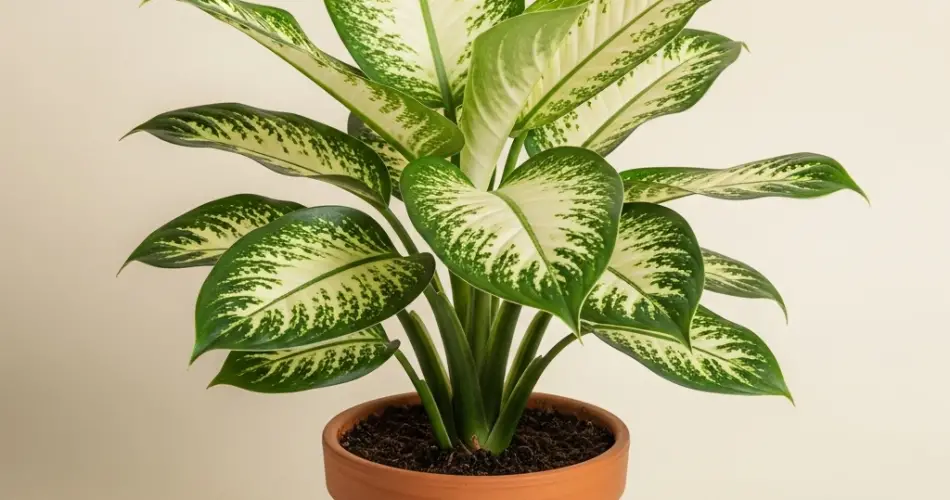Dieffenbachia, commonly known as dumb cane, is a favorite among indoor plant enthusiasts for its striking foliage and ability to thrive in low-light spaces. However, one of the biggest challenges when growing Dieffenbachia in containers is avoiding root rot, a condition caused by excessive moisture around the plant’s roots. Proper drainage and careful watering are crucial to keeping your Dieffenbachia healthy and thriving in pots.
Why Drainage Matters for Dieffenbachia
Like many tropical houseplants, Dieffenbachia enjoys moist soil but absolutely hates standing in water. When the roots are constantly wet, they begin to suffocate due to lack of oxygen, creating the perfect environment for harmful fungi and bacteria. Root rot not only damages the roots but can quickly kill the entire plant if not addressed.
Ensuring proper drainage is the best way to prevent this. It allows excess water to escape, air to reach the roots, and the soil to dry out between waterings. This balance is key to maintaining a healthy, lush Dieffenbachia.
Choosing the Right Pot
Start with a pot that has drainage holes at the bottom. This is non-negotiable when growing Dieffenbachia or any other moisture-sensitive plant. If you prefer decorative containers without holes, use a plastic grow pot with drainage and place it inside your chosen pot. Always remove the inner pot when watering to let excess water drain freely.
Pot material also plays a role:
-
Plastic pots retain more moisture, making them ideal for drier indoor climates.
-
Terracotta pots are porous and help wick moisture away from the soil, which is great if you tend to overwater or live in a humid area.
-
Ceramic pots are usually decorative but make sure they have proper drainage holes or use them as outer covers only.
Choose a pot that’s only slightly larger than the plant’s root ball. Oversized pots hold more soil and therefore more moisture, increasing the risk of root rot.
The Best Soil for Drainage
Standard potting soil is usually too dense for Dieffenbachia. You need a mix that drains quickly but still holds enough moisture to keep the plant hydrated.
A well-draining Dieffenbachia mix includes:
-
2 parts peat moss or coco coir (for moisture retention)
-
1 part perlite or pumice (for drainage)
-
1 part compost or aged bark (for nutrients and aeration)
This mix prevents the soil from compacting, which can suffocate roots and hold too much water. Avoid garden soil or clay-heavy mixes in containers—they tend to stay soggy and promote root rot.
Proper Watering Techniques
Watering is where many Dieffenbachia owners go wrong. This plant doesn’t like to dry out completely, but it also hates soggy soil. The goal is to maintain consistent, moderate moisture.
Follow these watering tips:
-
Water when the top inch of soil feels dry to the touch.
-
Use your finger or a moisture meter to check soil moisture before watering.
-
Water thoroughly until it begins to drain out of the bottom holes.
-
Discard any water collected in saucers or cache pots after 15 minutes.
In cooler months, reduce watering frequency, as the plant’s growth slows and soil takes longer to dry out.
Signs of Root Rot and How to Fix It
Catch root rot early, and your Dieffenbachia can recover. Watch for these warning signs:
-
Yellowing lower leaves
-
Mushy stems at the base
-
Foul smell from the soil
-
Wilting despite moist soil
If you suspect root rot, remove the plant from the pot and inspect the roots. Healthy roots are white or light tan and firm. Rotted roots appear black or brown and feel mushy.
To save your plant:
-
Trim away all rotted roots with sterilized scissors.
-
Wash the remaining roots gently.
-
Repot the plant in fresh, well-draining soil and a clean pot.
-
Hold off on watering for a few days to allow the roots to recover.
Preventing Future Issues
Along with using the right pot and soil, consider these additional tips:
-
Place the pot on a saucer filled with pebbles to improve humidity without trapping water under the roots.
-
Avoid watering on a fixed schedule. Instead, respond to your plant’s needs based on environmental conditions.
-
Ensure your potting area has good airflow and indirect light, helping the soil dry more evenly.
If you’re in a very humid climate, use a fan occasionally to help evaporate excess moisture around your plants. Good airflow also prevents fungal growth on the surface of the soil.
Final Thoughts
Dieffenbachia makes a stunning addition to any indoor space, but its health depends heavily on your attention to drainage. With the right pot, a breathable soil mix, and a mindful watering routine, you can prevent root rot and enjoy a thriving, vibrant plant year-round. Proper drainage isn’t just a gardening detail—it’s the foundation of container plant success, especially for moisture-sensitive plants like Dieffenbachia.



